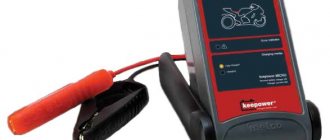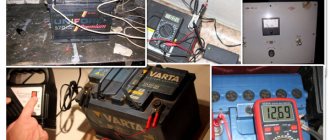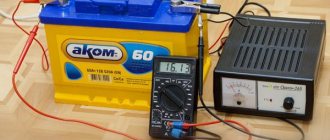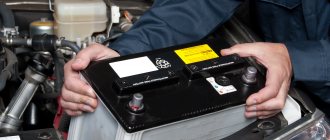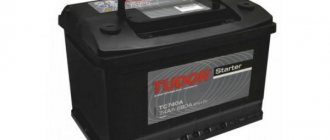The constant development of technology causes the development of its power sources, including batteries. If previously models with liquid electrolyte were most widespread, now gel electrolyte is increasingly being used as the basis for chemical reactions. Despite their high cost and difficulty in maintenance, such energy storage devices have a number of key advantages.
Comparison
What is the difference between a gel battery and a regular acid battery?
It contains the electrolyte not in liquid form, but in a silicon-bound gel substance. Accordingly, all the advantages of such an energy storage device grow from this factor. This:
- Long service life. The gel is not as chemically active as the alkaline-acid liquid in conventional batteries. There are cases of restoration of drive performance characteristics 12-14 years after the end of its service life. Yes, the gel dries out, but the rate of its deterioration is much lower than that of a conventional electrolyte.
- Virtually no maintenance procedures required. Therefore, gel energy storage devices in 99% of cases come in a hermetically sealed case, without the possibility of gaining access to the chemical fillers of the battery cans.
- Very weak sensitivity to shaking, swaying, and even complete turning over. What makes the device ideal for use in small equipment - scooters, hydraulic and regular motorcycles, mopeds. Such gel batteries are popular in the aircraft industry and among shipowners. Smaller sizes compared to classic batteries, with equal capacity, make them ideal for various devices, such as uninterruptible power supply devices.
- Low self-discharge. No more than 20% of energy leaves the drive when there is no load.
- A greater number of charge-discharge cycles compared to classical types allows longer and more intensive use of the energy storage device.
- Less sensitivity to temperature changes.
- No liquid acid solutions. Therefore, even if the seal of the case is broken, the battery will continue to work. This also provides greater safety for humans, since the gel does not flow.
- We can allow the battery to be discharged very low without impairing its reverse charging capabilities.
But as they say, the advantages of the drive also come with some disadvantages in its use, this is most noticeable in particular when charging gel batteries:
- Overheating when recharging. Batteries of this type are very sensitive to overheating. If the gel boils or peels off from the electrodes, then not only can the housing rupture as a result of the release of gases from the boiling gel, but the chemical cycle of energy conservation will also be disrupted. Accordingly, the device will no longer save energy.
- Memory effect. If the charge is carried out incorrectly, the efficiency of the energy element becomes much lower.
Advantages and disadvantages
Separately, it is worth taking a look at the pros and cons of gel batteries for vehicles. This will greatly help some motorists understand whether they should buy such batteries or not.
Strengths include:
- long service life;
- a significant number of withstand charge-discharge cycles;
- ability to withstand about 400 full discharges;
- minor loss of capacity when the battery is idle without operation;
- strength and reliability;
- use of modern technologies;
- low internal resistance;
- high efficiency indicators;
- completely maintenance-free type of battery;
- safety during operation.
But that's not all. Such batteries also have disadvantages.
The disadvantages are as follows:
- charging parameters must be strictly regulated and not go beyond the prescribed values, otherwise processes of destruction of internal components will begin;
- such batteries are more sensitive to severe frosts, since when the gel hardens, the characteristics of the electrolyte deteriorate and the electrochemical efficiency decreases;
- gel batteries are not characterized by the highest short circuit resistance;
- When compared with conventional lead-acid batteries, gel batteries are noticeably more expensive.
Everyone can now draw the appropriate conclusions for themselves and make a final decision regarding the purchase of a gel power source.
Safe charging with a conventional charger
Conventional chargers are not very suitable for charging gel drives, however, they can be used. How to properly charge and charge a gel battery with a regular charger? The basic safety principle for the subsequent operation of the battery is control and correct calculation of current components.
First you need to calculate how much current in amperes is required to charge the battery. To do this, information is taken on the maximum capacity in ampere hours for a specific model (often written directly on the case), and from there 10% is calculated for fast charging, or 5% for a safer current used. For example, the battery has a capacity of 150 Ah (ampere hours), which means the maximum charge current should be set to 15A, and ideally (but the charge recovery time for a gel battery will double) to 7.5A.
As for the volts supplied from the charger terminals, they must be set to the position intended for the standard battery voltage, 6V, 12V or 24V.
Now, as for chargers that do not have a current regulator. It is imperative to lower it, otherwise there will be unforeseen consequences. Amperes can be reduced by connecting a load in parallel to the electric charger - an incandescent lamp. You can use a buffer lead-acid battery for this. With a lamp, the voltage will also drop, but as for the buffer battery, it’s interesting. Scheme:
In theory, a regular battery will lower the amperes, since it is a stronger consumer and is located at the beginning of the parallel circuit. The volt parameters for both batteries should be the same. The remainder of the amperes will go into the gel electrolyte, which will help produce a “softer” charging. Only after assembling the circuit and turning it on should you check whether the gel storage has started to heat up. This can happen if the regular one is faulty.
How to understand that the gel battery is charged and ready to use
The easiest way, of course, is to regulate this process using an automatic charging station, since after the process is completed it will stop supplying power.
If you use a conventional charger in manual mode, the charging process must be completed when the charge is equal to 80% of the battery capacity.
Such results are achieved if the battery is charged according to the rules, i.e. use a voltage of 10% of the capacity for 7-8 hours. If the voltage is less, the time of this process will increase.
You can also use more precise devices, for example, as a load fork. It allows you to accurately determine all the necessary parameters.
In the case of a gel battery, the charging process can be completed if the plug shows a value of approximately 0.8 of the starting current value. It is indicated either on the battery itself or in the documentation for it. In the future, to gain a full 100% charge, gel types of batteries must be charged with a current that is only 0.1% of the battery capacity.
This procedure will take about 4-6 hours if we are talking about a car battery that is supplied with a voltage of 1 Ampere.
Specialized chargers for gel batteries
There are also specialized chargers that, having low ampere output currents, allow you to charge such drives either in a fully automatic mode or semi-manually. Such chargers are made taking into account the charging characteristics of gel batteries. The most complex of them allow you to restore batteries of different voltages. When purchasing simpler ones, you need to pay attention to the correspondence of the output current (if there is no switch).
Reference! It is not recommended to charge gel batteries more than a couple of times a year.
Requirements for a charger for gel batteries
In conclusion, let's list the main wishes for a charger for a gel battery.
- Ability to adjust the charge current;
- The charger (charger) must be designed for gel batteries or have a separate mode for working with them;
- The device must have a temperature compensation function;
- There must be a range of operating temperatures (usually from +5 to +40);
- It is highly desirable to carry out the charging process in stages in automatic mode (3-4 stages).
Requirements
Basic requirements for specialized memory devices:
- Regulation of the charging voltage of the gel battery.
- Adaptation of the current used for various external conditions (air temperature in the room where the charge level is restored).
- Adaptation of the number of amperes, depending on the temperature of the battery itself at various stages.
- Automated voltage change, depending on the stage. It is desirable to have a charger that allows saturation of the battery in three stages: 1 - increased voltage;
- 2 - constant voltage support, with a decrease in the number of amperes;
- 3 - minimum recharging with a minimum of volts and amperes.
Important parameters and features when charging a gel battery
The maximum permissible battery charging voltage is, as a rule, 14.3–14.4 volts. But before charging, you must check this value for your battery. You can view it on the case or in the device passport. It is designated as cycle use.
The photo shows the maximum permissible charging voltage of a gel battery.
So, for the model in the photo above, cycle use is 14.1–14.4 volts. There is also another meaning, designated standby use.
The photo shows the voltage that needs to be supplied to the gel battery to keep it in working condition. For the model in the photo, the standby use voltage is 6.75–6.9 volts. This is the voltage that must be supplied to the battery in standby mode to maintain it in working condition.
As for the charging current, the following value can be found on the case and in the documents for the battery - max initial current.
The maximum permissible charging current is highlighted in the photo. For the sample in the previous image, the value is 16.5 A. Do not set the current above this value, otherwise the battery will be damaged. And another important parameter that you can’t do without is the battery charging current. It is calculated as battery capacity / 10. See the capacity value in Ah.
For the model above, the capacity is 7 Ah. Accordingly, the charging current needs to be set to 700 mA. Return to content.
Full charge time
How long does it take to charge a gel battery? It is very easy to calculate - the battery capacity ampere*hours is divided by the set current of the charger. The result obtained is the time in hours that the battery requires to be completely saturated with energy. This time cannot be exceeded! Overheating will begin. It is even recommended to keep charging a little less time. Let the battery not be charged to 100%, but at least it will remain intact.
Advice! When charging, if the battery becomes hot, it must be immediately disconnected from the charger and allowed to cool. If this is not done, the boiling gel will destroy the battery beyond repair. In addition, when recharging, it is worth reducing the current.
How to check a gel battery for the level of already accumulated charge, so as not to miss the moment of shutdown? To do this, use a regular multimeter. The battery is periodically disconnected from the charger and the voltage at the storage terminals is measured. If the voltage there rises above 12.6V for 12 volts, 6.6V for 6V, or 24.6V for 24V, then the charge is fully charged. There is no point in charging further, especially since this can lead to heating of the element of the battery collector cans.
Maintenance of gel batteries
Over time, the gel dries out, losing its electrolytic properties. This happens, of course, at a lower speed than in lead-acid batteries. But this is a common reason for a decrease in battery efficiency.
How to restore and revive the gel battery in such cases? The density can be increased to a certain limit by adding distilled water to the battery jars. To do this, carefully remove the caps on each of the battery tanks, then the rubber plugs, then pour the distillate into each with a small 2 ml syringe. With the plugs open, the battery is left for three to four hours to allow the reaction to occur and the liquid to be absorbed into the gel. Check the voltage level at the battery terminals. If everything is in order, the caps are put back in place and the battery is charged.
Actually, increasing the density, as well as periodically recharging up to 100% twice a year, is actually all the available maintenance for gel batteries.
Instructions for charging a motorcycle battery
12.7 V is the normal voltage of a gel battery for a motorcycle.
The battery of a snowmobile or motorcycle has a lower capacity than the car's power source. A universal car charger does not produce low currents.
Smart devices, such as Benton BX, are used to charge a motorcycle battery. The battery is examined using a multimeter.
The device measures the voltage at the terminals. A value of 12.7 V is considered normal. At a lower value, the gel battery requires recharging.
To extend the battery life, charge it once every 2 months. After long-term storage, the charge is restored within 12-14 hours by applying a current equal to 10% of the capacity. Do not turn off the charger until power is fully restored. You need to monitor the temperature of the battery case.
How to check a gel battery
Some types of testing of gel drives:
- First you need to lightly shake the battery while listening. If an extraneous sound is heard inside, then with a 90% probability the battery plates have come loose. This type of storage device can only be recycled. It will not be possible to restore it at home.
- If the battery is swollen or even one bank on it is “swollen,” it is also beyond repair.
- If everything seems to be intact, but the voltage on the contacts is zero, and the gel battery does not take a charge, then this is a classic discharge of the device to zero. A charger will help here; it can be used to “push” the battery so that it begins to gain energy. Why do they first try to charge it with an increased current (for 12V -15V, for 6-8V, for 24 - 26V). As soon as the battery begins to charge, the voltage is lowered to standard charging parameters. In this case, the drive's operating parameters will most likely deteriorate.
Extending the life of the gel battery
If desired, you can significantly increase the service life of a gel battery; you just need to lower the output voltage to 0.3 A. Of course, the battery will begin to charge much longer, at least a day, but the reduction in electrolyte will be reduced to almost zero. But there is one key factor here - the electrical voltage should not be higher than 15 V, otherwise the device will simply swell from the inside. This method will help you restore a gel battery that has been completely discharged, and as we have already written, it is better not to allow this to happen.
Conclusion
The future lies in the creation of such storage devices. Smaller size (and often weight), with a capacity similar to its older lead-acid counterparts, is a big plus. And all this despite the fact that they are much more universal in use, safe, and can also be used in a wide range of devices, from automotive equipment to microelectronics.
https://www.youtube.com/watch?v=inwlslONUuE
You may also be interested.
Batteries 0

